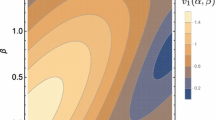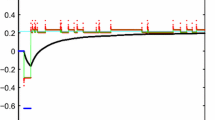Abstract
A quantum walk (QW) simulating the flat \((1 + 2)\)D Dirac equation on a spatial polar grid is constructed. Because fermions are represented by spinors, which do not constitute a representation of the rotation group \({\mathrm{SO}}(3)\), but rather of its double cover \({\mathrm{SU}}(2)\), the QW can only be defined globally on an extended spacetime where the polar angle extends from 0 to \(4 \pi \). The coupling of the QW with arbitrary electromagnetic fields is also presented. Finally, the cylindrical relativistic Landau levels of the Dirac equation are computed explicitly and simulated by the QW.

Similar content being viewed by others
Data Availability Statement
Data will be made available on reasonable request.
References
Feynman, R.P., Hibbs, A.R.: Quantum Mechanics and Path Integrals. McGraw-Hill Book Company (1965)
Schweber, S.S.: Feynman and the visualization of space-time processes. Rev. Mod. Phys. 58(2), 449 (1986). https://journals.aps.org/rmp/abstract/10.1103/RevModPhys.58.449
Aharonov, Y., Davidovich, L., Zagury, N.: Quantum random walks. Phys. Rev. A 48(2), 1687 (1993). https://journals.aps.org/pra/abstract/10.1103/PhysRevA.48.1687
Meyer, D.A.: From quantum cellular automata to quantum lattice gases. J. Stat. Phys. 85(5–6), 551–574 (1996). https://link.springer.com/article/10.1007/BF02199356
Ambainis, A.: Quantum walk algorithm for element distinctness. SIAM J. Comput. 37(1), 210–239 (2007). https://dl.acm.org/doi/10.1137/S0097539705447311
Magniez, F., Nayak, A., Roland, J., Santha, M.: Search via quantum walk. SIAM J. Comput. 40(1), 142–164 (2011). https://doi.org/10.1137/090745854
Manouchehri, K., Wang, J.B.: Physical Implementation of Quantum Walks. Springer, Berlin (2014)
Strauch, F.W.: Connecting the discrete-and continuous-time quantum walks. Phys. Rev. A 73, 054302 (2006). https://link.aps.org/doi/10.1103/PhysRevA.74.030301
Strauch, F.W.: Relativistic effects and rigorous limits for discrete- and continuous-time quantum walks. J. Math. Phys. 48, 082102 (2007). https://doi.org/10.1063/1.2759837
Kurzynski, P.: Relativistic effects in quantum walks: Klein’s paradox and Zitterbewegung. Phys. Lett. A 372, 6125 (2008). https://www.sciencedirect.com/science/article/abs/pii/S0375960108012115?via%3Dihub
Chandrashekar, C.M.: Two-component Dirac-like Hamiltonian for generating quantum walk on one-, two- and three-dimensional lattices. Sci. Rep. 3, 2829 (2013). https://www.nature.com/articles/srep02829
Shikano, Y.: From discrete time quantum walk to continuous time quantum walk in limit distribution. J. Comput. Theor. Nanosci. 10, 1558 (2013). http://www.aspbs.com/ctn/contents-ctn2013.htm
Arrighi, P., Nesme, V., Forets, M.: The Dirac equation as a quantum walk: higher dimensions, observational convergence. J. Phys. A 47, 465302 (2014) https://iopscience.iop.org/article/10.1088/1751-8113/47/46/465302/meta
Arrighi, P., Facchini, S., Forets, M.: Quantum walking in curved spacetime. Quant. Inform. Process. 15(8), 3467–3486 (2016). https://link.springer.com/article/10.1007/s11128-016-1335-7
Di Molfetta, G., Honter, L., Luo, B., Wada, T., Shikano, Y.: Quantum Stud.: Math. Found., 2:243, (2015) https://link.springer.com/article/10.1007/s40509-015-0042-x
Pérez, A.: Asymptotic properties of the Dirac quantum cellular automaton. Phys. Rev. A 93(1), 012328 (2016). https://journals.aps.org/pra/abstract/10.1103/PhysRevA.93.012328
Bisio, A., D’Ariano, G.M., Perinotti, P.: Special relativity in a discrete quantum universe. Phys. Rev. A 94(4), 042120 (2016)
Di Molfetta, G., Brachet, M., Debbasch, F.: Quantum walks as massless Dirac fermions in curved space-time. Phys. Rev. A 88(4), 042301 (2013). https://link.aps.org/doi/10.1103/PhysRevA.88.042301
Di Molfetta, G., Brachet, M., Debbasch, F.: Quantum walks in artificial electric and gravitational fields. Physica A 397, 157–168 (2014). http://www.sciencedirect.com/science/article/pii/S0378437113011059
Arnault, P., Debbasch, F.: Landau levels for discrete-time quantum walks in artificial magnetic fields. Physica A 443, 179–191 (2016). https://doi.org/10.1016/j.physa.2015.08.011
Arnault, P., Debbasch, F.: Quantum walks and discrete gauge theories. Phys. Rev. A 93(5), 052301 (2016). https://doi.org/10.1103/physreva.93.052301
Arnault, P., Di Molfetta, G., Brachet, M., Debbasch, F.: Quantum walks and non-abelian discrete gauge theory. Phys. Rev. A 94(1), 012335 (2016). https://doi.org/10.1103/PhysRevA.94.012335
Arnault, P., Debbasch, F.: Quantum walks and gravitational waves. Ann. Phys. N. Y. 383, 645–661 (2017). https://doi.org/10.1016/j.aop.2017.04.003
Bisio, A., D’Ariano, G.M., Tosini, A.: Quantum field as a quantum cellular automaton: the Dirac free evolution in one dimension. Ann. Phys. - N. Y. 354, 244–264 (2015). https://doi.org/10.1103/physreva.98.032333
Márquez-Martín, I., Arnault, P., Di Molfetta, G., Pérez, A.: Electromagnetic lattice gauge invariance in two-dimensional discrete-time quantum walks. Phys. Rev. A 98(3), 032333 (2018). https://doi.org/10.1103/physreva.98.032333
Bialynicki-Birula, I.: Weyl, Dirac, and Maxwell equations on a lattice as unitary cellular automata. Phys. Rev. D 49(12), 6920 (1994). https://journals.aps.org/prd/abstract/10.1103/PhysRevD.49.6920
Cedzich, C., Rybár, T., Werner, A.H., Alberti, A., Genske, M., Werner, R.F.: Propagation of quantum walks in electric fields. Phys. Rev. Lett. 111(16), 160601 (2013). https://link.aps.org/doi/10.1103/PhysRevLett.111.160601
Cedzich, C., Geib, T., Werner, A.H., Werner, R.F.: Quantum walks in external gauge fields. J. Math. Phys. 60(1), 012107 (2019). https://doi.org/10.1063/1.5054894
Jay, G., Debbasch, F., Wang, J.B.: Dirac quantum walks on triangular and honeycomb lattices. Phys. Rev. A 99(3), 032113 (2019). https://journals.aps.org/pra/abstract/10.1103/PhysRevA.99.032113
Arrighi P, Di Molfetta G, Márquez-Martín I, Pérez A.: Dirac equation as a quantum walk over the honeycomb and triangular lattices. Phys. Rev. A. (2018) https://doi.org/10.1103/physreva.97.062111
Jay, G., Debbasch, F., Wang, J.B.: A new method to building Dirac quantum walks coupled to electromagnetic fields. Quant. Inform. Process. 19, 422 (2020). https://www.springerprofessional.de/en/a-systematic-method-to-building-dirac-quantum-walks-coupled-to-e/18610394
Debbasch, F.: Action principles for quantum automata and lorentz invariance of discrete time quantum walks. Ann. Phys. N. Y. 405, 340–364 (2019). https://doi.org/10.1016/j.aop.2019.03.005
Johnson, R.C.: Angular momentum on a lattice. Phys. Lett. B 114(2–3), 147–151 (1982). https://www.sciencedirect.com/science/article/abs/pii/0370269382901344
Moore, D.C., Fleming, G.T.: Angular momentum on the lattice: the case of nonzero linear momentum. Phys. Rev. D 73(1), 014504 (2006). https://journals.aps.org/prd/abstract/10.1103/PhysRevD.73.014504
Sajid, M., Asbóth, J.K., Meschede, D., Werner, R.F., Alberti, A.: Creating anomalous Floquet Chern insulators with magnetic quantum walks. Phys. Rev. B (2019) https://doi.org/10.1103/physrevb.99.214303
Wald, R.M.: General Relativity. University of Chicago press, Chicago (2010)
Author information
Authors and Affiliations
Corresponding author
Ethics declarations
Conflict of interest
On behalf of all authors, the corresponding author states that there is no conflict of interest.
Additional information
Publisher's Note
Springer Nature remains neutral with regard to jurisdictional claims in published maps and institutional affiliations.
Appendices
Appendix A: The polar Dirac equation
In \((1+2)\)D flat spacetime, the Cartesian Dirac equation (CDE) can be written
with the operator \(\mathcal D\) defined (in natural units \(\hbar =c=1\)) by
where (t, x, y) are Minkowski coordinates and m is the mass of the particle. The indices \((A, B) \in \{ L, R \}^2\) refer to components on a Cartesian, point-independent spin basis which we denote by \(\left( b_L, b_R\right) \). We choose a representation where, in this basis, the \(\gamma \) operators read
where the \(\sigma \)’s are the Pauli matrices and the notation \([(\gamma ^i)^A_B]\) represents the matrix formed by the components of the operator \(\gamma ^i\) in the basis \(\left( b_L, b_R\right) \).
To obtain the PDE from the CDE, one must first use polar coordinates \((r, \theta )\) instead of Cartesian coordinates, and then also change the spin basis basis, replacing the Cartesian spin basis by the polar spin basis \((b_-, b_+)\) obtained from \((b_L, b_R)\) by performing a rotation of angle \(\theta \) in spin-space. According to general spinor theory [36], this rotation reads:
Performing both operations leads to
where
and
Note that the operators \(\gamma ^i\) and \(\tilde{\gamma }^i\) are represented by the same matrices, but in different bases.
As usual, the coupling of the Dirac fermion with an electromagnetic field with 3-potential \((A_\mu )=(A_t,A_r,A_\theta )\) is achieved by adding \(+\mathrm {i}e A_\mu \) to \(\partial _\mu \) for \(\mu = 0, 1, 2\). We choose to set the charge e to \(-1\) and introduce \({\mathcal D}_\mu = \partial _\mu - i A_\mu \), so the Dirac equation for \(\Psi \) in polar coordinates and polar spin basis cab be abbreviated into
which we call the polar Dirac equation (PDE). We use this compact form in the article when no confusion with the CDE seems possible. Note that polar coordinates are not defined at \(r = 0\); therefore, the PDE is non-singular over the definition domain of polar coordinates.
Let us conclude this section by pointing out a very important property of the PDE. The second polar coordinate \(\theta \) is an angle. Thus, the components \(\Psi ^L\) and \(\Psi ^R\) of \(\Psi \) in the Cartesian spin basis, when written as functions of r and \(\theta \), are \(2 \pi \)-periodic functions of \(\theta \). So are the time component \(A_t\), the Cartesian components \(A_x\), \(A_y\) and the polar components \(A_r\) and \(A_\theta \) of the potential. The components \(\Psi ^-\) and \(\Psi ^+\) of \(\Psi \) in the polar spin basis are linear combinations of \(\Psi ^L\) and \(\Psi ^R\) with coefficients \(\cos (\theta /2)\) and \(\sin (\theta /2)\). These two coefficients are \(2 \pi \)-anti-periodic in \(\theta \) i.e. they obey \(f (\theta + 2 \pi ) = - f(\theta )\) for all \(\theta \in [0, 2 \pi [\). It follows that the polar components \(\Psi ^-\) and \(\Psi ^+\) are also \(2 \pi \)-anti-periodic in \(\theta \). This expresses the fact that spinors belong to representations of the double cover of the rotation group \(\text{ SO }(2, {\mathbb R})\) and, thus get an extra minus sign after a rotation by \(2 \pi \). Thus, the PDE is defined over \(\{(r, \theta ), r \in {\mathbb R}^*_+, \theta \in [0, 4 \pi [ \}\) and should only be used with initial conditions which are \(2 \pi \)-anti-periodic in \(\theta \). By construction, the PDE conserves this anti-periodicity over time. Finally, only half integer modes \(k = s + 1/2\), \(s \in \mathbb Z\) enter the decomposition of the polar spinor components \(\Psi ^\pm \) in terms of Fourier modes \(\exp (\mathrm {i}k \theta )\).
Appendix B: Angular momentum from the polar Dirac equation
The angular Fourier transform \(\tilde{f}\) of an arbitrary function f of the variables \((r, \theta )\) is defined by
Since \(\theta \) is bounded by \(4 \pi \), its conjugate variable \(\kappa \) is discrete, with step \(\Delta \kappa = (2 \pi )/(4 \pi ) = 1/2\). Since \(\theta \) is continuous, \(\kappa \) is unbounded. A simple and common choice for the range of \(\kappa \) is therefore \(\left\{ 0, \pm 1/2, \pm 1, ...\right\} \). As explained above, the potential components have integer angular Fourier modes while the polar spinor components only have half-integer angular Fourier modes.
If the potential components \(A_t\), \(A_r\) and \(A_\theta \) do not depend on \(\theta \), the Fourier transform of the polar spinor components obeys
with
Thus, each angular Fourier component evolves independently of the others. Moreover, each Fourier component evolves in a unitary way i.e. the operator \({ L}^D\) conserves the norm of each angular Fourier component.
The angular momentum operator \(\hat{J}\) is defined by
This definition is equivalent to
The expectation value of \(\hat{J}\) is conserved by \(L^D\) if all potential components are independent of \(\theta \).
It is instructive to rewrite the expectation value of the operator \(\hat{J}\) in terms of the Cartesian spin components. One finds
where the metric \(\lambda \) in spin space is defined by \(\lambda _{AB} = 1\) if \(A = B\) and 0 otherwise. Equation (B6) shows that the total angular momentum of the spinor is the sum of the kinetic angular momentum and of the spin.
Appendix C: Relativistic Landau levels
The eigenstates common to the Dirac Hamiltonian and the angular momentum operator are of the form
with
The computation of these eigenstates is best carried out by replacing the components \(\xi ^-\) and \(\xi ^+\) of \(\Xi \) by the new unknown functions
The eigenfunctions \(u^\pm _{E,\kappa }\) associated with energy E and angular momentum \(\kappa \) obey
The equations (C4) are solved by changing, first the unknown functions, then the variable. One first introduces \(v^\pm =r^{\pm \kappa }e^{\mp \frac{1}{4}B r^2}u^\pm \) and then changes variable to \(x = \mid B \mid r^2/2\). These substitutions transform (C4) into standard equations solved by Laguerre polynomials. For example, introducing \(n=\frac{m^2-E^2}{2B}\) and \(\alpha =-\kappa -\frac{1}{2}\), one finds that \(v^+\) obeys
which is solved by
where C is a constant and \(L_n^\alpha \) is an associated Laguerre polynomial. The final, normalized expression for \(u^\pm \) is
with
Rights and permissions
About this article
Cite this article
Jay, G., Arnault, P. & Debbasch, F. Dirac quantum walks with conserved angular momentum. Quantum Stud.: Math. Found. 8, 419–430 (2021). https://doi.org/10.1007/s40509-021-00253-x
Received:
Accepted:
Published:
Issue Date:
DOI: https://doi.org/10.1007/s40509-021-00253-x




